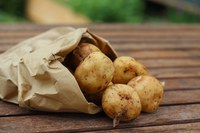Dakota Gardener: How to plant potatoes
(Click an image below to view a high-resolution image that can be downloaded)
By Tom Kalb, Horticulturist
NDSU Extension
Gardeners in North Dakota love to grow and eat potatoes. The average North Dakotan eats over 100 pounds of spuds per year, making it our favorite vegetable.
The planting season for potatoes is coming. Here are some quick tips on how to get your crop off to a great start.
Get your potato seed from garden centers or seed companies. This seed is certified to be free of diseases. Do not use potatoes from the grocery store or stored from last year’s crop. These potatoes may have diseases in them.
Plant your seeds in a well-drained, fertile soil. Potato plants are especially hungry early in the growing season. An application of 1 pound of 10-10-10 fertilizer scattered along every 10 feet of row at the time of sowing is generally recommended.
Lots of varieties grow well here. Red-skinned varieties are most popular. These tend to have a waxy texture and are used for boiling, roasting and salads. Dark Red Norland is the favorite red-skinned potato. Chieftain and Red La Soda will produce good yields, too.
Yellow-skinned varieties are gaining in popularity. These varieties are good for boiling, roasting, salads, soups and frying. Satina, Yukon Gem and Yukon Gold are good choices for North Dakota.
White-skinned and Russet varieties are best for baking and making French fries. Caribou Russet and Gold Rush grow well in our state.
My favorite variety is Purple Viking. Its purple skin has beautiful pink splotches. Purple Viking tolerates drought and resists scab disease. It makes great mashed potatoes. You won’t find it at garden centers, but several companies offer it online.
The best potato seed is the size of an egg or golf ball and has about two to three eyes. If you have larger seeds, you can cut them to fit this size. If a seed has lots of eyes at one end, slice the seed so the eyes are evenly distributed among the cuttings.
Seeds that are cut should be planted immediately or allowed to heal for 4 to 10 days before planting. The wounds heal best at 50 to 60 degrees and high humidity. You can create high humidity by placing a wet burlap bag over the cut seed.
Seeds are generally planted two weeks before our last frost. For most of us, this means we can plant around May 1.
To prevent seed rot, the soil temperature at planting should be around 55 to 60 degrees. The best tool to measure soil temperature is a soil thermometer, but a meat thermometer can be used. Insert the thermometer 4 inches into the soil. Test it in the morning when the soil is coldest. Monitor for about 3 days to get a consistent reading.
Soil temperatures can be found on the North Dakota Agricultural Weather Network website. Go to www.ndawn.org and click on Deep Soil Temperatures. Look for the readings at four inches in depth.
Plant your tubers about 4 to 6 inches deep (the length of a dollar bill) and space them 12 inches apart. Closer spacing can lead to smaller tubers and wider spacing can lead to larger tubers.
One pound of potato seed will plant about 6 to 8 feet of row. You can expect the seeds to sprout within a couple weeks.
Good luck! These tips will get your potato crop off to a great start. I hope you harvest lots of tasty spuds this fall.
For more information about gardening, contact your local NDSU Extension agent. Find the Extension office for your county at ndsu.ag/countyoffice.
NDSU Agriculture Communication – April 11, 2024
Source: Tom Kalb, 701-877-2585, tom.kalb@ndsu.edu
Editor: Kelli Anderson, 701-231-7006, kelli.c.anderson@ndsu.edu




